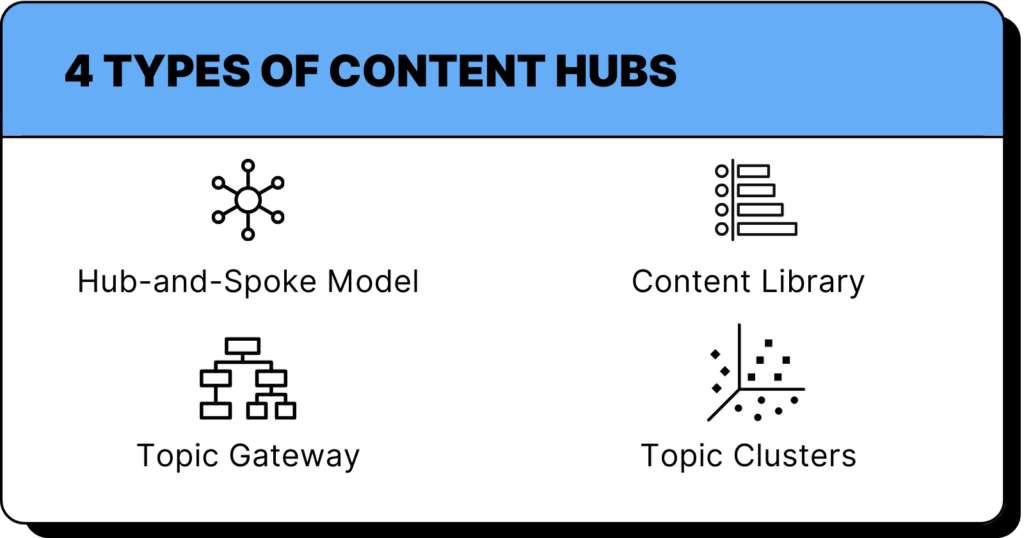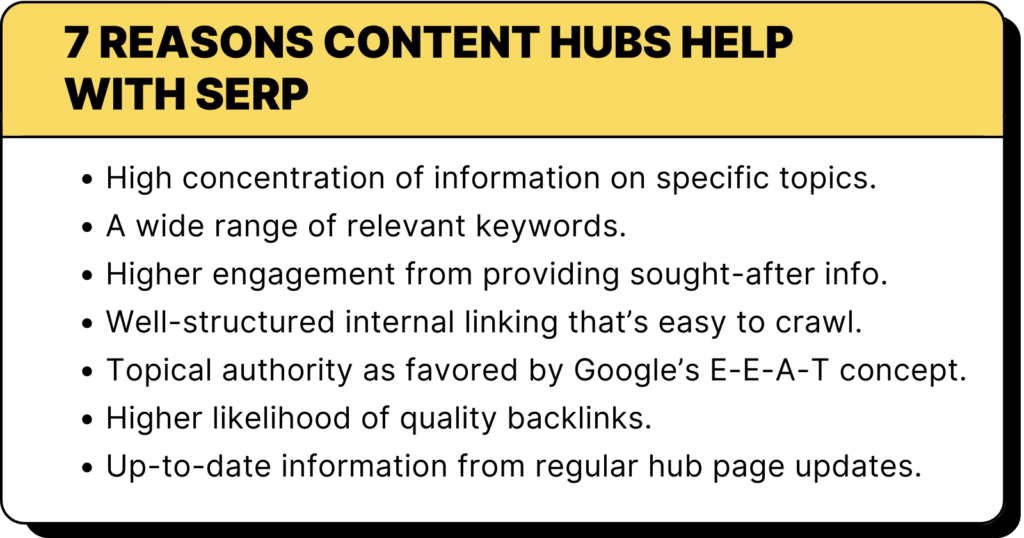When you walk into your local library, you won’t see books scattered about without labels, guides or organization. Instead, you’ll find them neatly arranged on shelves according to the Dewey decimal system. This creates organization, encourages discoverability and crafts a larger narrative around similar topics. Content hubs are the next-best thing for brand websites: a systematic approach to organizing information that enhances user engagement and helps you attain search engine results page (SERP) placements.
What Is a Content Hub?
A content hub is a collection of content organized around a theme or topic. This provides a starting point for visitors while helping them explore anything related to a specific topic. Whether it’s blog posts, infographics, videos or podcasts, it all goes into this hub.
For example, an industrial products manufacturer might have a content hub focused on educational resources, such as blogs, white papers and webinars. A second hub might focus on products, including product pages, videos and customer testimonials. A clothing retailer may have one about leisurewear, another about women’s fashion and a third about formal wear.

4 Types of Content Hubs
Content hubs come in many forms. One type you won’t see below is the pillar page, although it’s sometimes used interchangeably with a content hub. One way the terms differ is that pillar pages collect all your knowledge and thought leadership on a topic into one comprehensive page, whereas content hubs are designed to send readers to several other related pages via carefully organized internal links.
Here are four common approaches you’ll see from many brands.
Hub-and-Spoke Model
The hub-and-spoke model centers on a hub that’s the main guide or overview. Related subtopics are the “spokes” that link back to the hub. This structure improves the user experience and journey by providing tremendous detail and an organized, guided exploration. The hub-and-spoke model relies on internal linking, which is beneficial for SEO.
A brand’s hub-and-spoke content hub might start with a central blog post on a core topic, with individual blog posts categorized around articles on related topics. For instance, a technology company might have a hub focused on tech innovations (or a broad category), with the spokes covering specific areas such as artificial intelligence, virtual reality or cybersecurity.
A travel website might feature a country or state as a hub page providing general tourist information. The spokes could be detailed city guides or focus on categories for the geography, such as attractions, hotels, cultural practices or culinary specialties.
The hub-and-spoke model can succeed for B2B (such as Backlinko’s content marketing hub) and B2b (NerdWallet’s Personal Finance hub) alike.
Content Library
This digital archive format focuses on organizing content by types, such as e-books, how-to videos, templates, podcasts and more. It’s particularly effective for brands with a large volume of diverse content that want to offer a one-stop shop for information.
An ideal example of this type of content hub is American Express Business Class (formerly Open Forum). It contains resources arranged by type, including articles, podcasts and videos.
Other brands will create content libraries as an enticement to get users to share their email address or pay a subscription fee for access. Users know they’re getting access to a deep, thoughtful collection of content, while the brand gets more information on the user — and potentially a new customer.
Topic Gateway
A topic gateway content hub acts as an introductory portal, directing visitors to content about related subtopics on different sections of the website via calls to action and strategic links.
Topic gateways are commonly seen on sites offering educational content or are industry-specific, such as those focusing on finance, law or real estate. Healthcare and wellness websites, for example, might have topic gateways dedicated to types of illnesses and diseases, medical treatments or wellness practices. Each section could include a variety of resources related to the topic and the ability to navigate elsewhere within the site.
The Salesforce blog hub is a gateway to numerous blogs addressing different topics, such as careers, research and engineering.
Topic Clusters
Topic clusters are a type of content hub organized by specific subjects or themes. (Zapier’s remote work hub is a good example.) All content assets about a certain topic exist on the same webpage or in the same section of a website. Users can navigate through related topics easily, while the website organization can bolster the site’s authority for that domain or for a set of keywords.
A digital marketing website might have a central hub page on SEO best practices, with linked cluster articles covering subtopics such as keyword research, link building, local SEO and mobile optimization.
The choice of hub design depends on the nature and volume of your content, the topic at hand and your audience’s preferences.
Benefits of Content Hubs
Content hubs are a strategic choice. Rather than just publishing a stream of content in reverse-chronological order, you’re aligning your content strategy with how you organize your website and how you place internal links. Here are some of the benefits of well-executed content hubs.
Increased Engagement
Webinar hosting company On24 thinks of content hubs as a pathway to “binge-worthy content” that helps prospects learn quickly, yields intent data and quickens the customer relationship journey. All of these are forms of the engagement your brand website needs, especially at the top of the funnel.
Content hubs offer structure and purpose, making it easier for users to find what they’re looking for — and even interesting content they weren’t originally looking for. Most users won’t engage with confusing or disorganized websites, especially if they can quickly look elsewhere for useful content.
Well-organized content hubs also make it easy for users to take further action, whether it’s sharing your content, signing up for a newsletter, downloading an asset or registering for a webinar.
Higher Search Rankings
Content hubs display topical authority signals to search engines. By housing many assets under one umbrella, you demonstrate the type of expertise Google wants to reward. This consolidates link equity and page authority for better overall visibility.
Additionally, internal linking between content hub articles facilitates site crawling. The interconnectivity and anchor text help search bots index new pages faster. Any individual piece has multiple chances to capture the searcher’s interest, thanks to its strategic connections.
Impressing your audience is paramount, but catching the discerning eyes of search engine bots is just as crucial. Content hubs signal a topical authority, providing clear, deep, focused coverage of a subject, a green signal for search engine algorithms.
A case study from digital marketing company Portent revealed that organic search results from content hub SEO drove 3.3 million additional organic sessions to a client’s website. This 207% increase was fueled by massive gains in the top three and top 10 keyword rankings.
Defined Content Strategy
Content brands lose control of their editorial calendar when they don’t have a long-term plan for what to publish or why. While thought leadership and one-off articles are valuable, an entirely ad hoc publishing strategy can cause production problems and leave your blog and brand without an identity.
Content hubs commit you to key topics that drive business value and help your target audience find valuable information. Combine that with thoughtful SEO research and a crack writing team, and you can quickly sharpen and streamline your content production.

How Content Hubs Help You Obtain SERP Features
Content hubs benefit from the same SEO principles as any piece of content — keyword integration, on-page optimization, use of meta tags, internal linking and so forth — but their structure takes that to the nth degree. This means higher keyword rankings and the potential for key SERP features, such as featured snippets and image packs.
Here are seven reasons why content hubs contribute to SEO and SERP gains:
- Content hubs typically consist of detailed, thorough information on a specific topic. Search engines favor this high-quality content because it provides user value, often answering many related queries in one place.
- Hubs naturally incorporate a range of relevant keywords and phrases. With keyword-rich content and a strong internal linking strategy, you can quickly rank for a variety of related search terms and catch Google’s attention.
- Content hubs often lead to increased user engagement (e.g., time spent on page, low bounce rates, etc.) because they offer a wealth of information. Search engines interpret this engagement as a sign of the content’s value, boosting its ranking.
- Content hubs are typically well-structured, with internal linking between different pages or sections. This helps users navigate the content more effectively and allows search engines to crawl and index the site more efficiently.
- By covering a topic extensively, content hubs position the website as an authority on the subject. Search engines, especially Google, prioritize content from sources that demonstrate experience, expertise, authority and trustworthiness (E-E-A-T).
- Content hubs are more likely to attract quality backlinks from other websites, a key ranking factor.
- Regular updates keep information current, another factor that positively impacts SERP.
How to Create a Content Hub
Whatever approach to content hubs you take, there are key steps you need to take for an SEO-optimized site and a long-term content production strategy that supports this effort.
Define Clear Objectives
Start by defining clear, measurable objectives for the content hub. This might include specific engagement metrics, SEO goals or lead generation targets.
Understand Your Audience (and Your Business)
Conduct audience research to understand their interests, pain points and content preferences. This ensures the content hub is tailored to meet their needs and interests. Likewise, make sure your content hubs have some relation to your products or services, as well as your messaging and point of view.
Balance New and Refreshed Content
Conduct a content audit to understand what’s performing well, what needs a boost and what is no longer relevant. This step will also help you define your content hubs and subtopics. From there, unless you have no history of producing content, you can build an editorial calendar with a mix of brand-new blog posts and rewrites of existing content.
Don’t Forget About SEO
Your content hub should be designed with SEO in mind at every step of the way, from the keywords you choose to how you structure internal links to the various aspects of technical SEO, including your website speed.
Monitor Performance
This is where your content marketing KPIs come into play. Review a variety of analytics regularly to identify engagement, SEO gains, referral traffic opportunities, other traffic sources and more. Remember that content hubs are a living entity, always in need of refinement.
Add Content Hubs to Your Toolkit
Content hubs are impressive-looking, but they’re not just for show. They’re a pivotal part of a modern content marketing strategy that can focus your content strategy while improving user engagement and SEO performance.
As a content marketing leader, consider how your brand can use content hubs to expand your subject-matter authority and engage future customers. Now is the time to harness the power of content hubs for your content team.
For more content marketing insights, sign up for our weekly newsletter!






